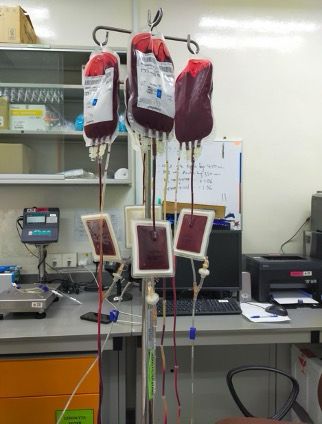
Pelajar Latihan Industri


A leukoreduced blood product is a blood product with a reduced number of leukocyte or white blood cells, achieved through a process called leukoreduction [1-2]. The primary purpose of this process is to reduce the risk of adverse transfusion reactions [1]. The most common adverse effects associated with leukocytes include immunomodulatory effects, graft-versus-host disease (GVHD), platelet refractoriness, alloimmunisation to human leukocyte antigens (HLA), and febrile non-haemolytic transfusion reaction (FNHTR) [1,3]. Adverse transfusion reactions may occur due to errors during the collection, processing, or storage of whole blood. During storage, when leukocytes degrade, inflammatory mediators like cytokines, interleukins (IL-1 and IL-6), and tumour necrosis factor are released. Moreover, throughout the transfusion, metabolically active cells and leukocyte antigens have the ability to multiply and produce immunological modifiers that impact the receiver. In response to these modifiers, the recipient will simultaneously produce their own immune mediators, which will further impact the clinical response [4]. Many studies have proved that leukoreduction is able to reduce adverse transfusion reactions. A significant reduction in FNHTR was reported in five studies [1], while two studies showed a decrease in transfusion-related acute lung injury (TRALI), and one study found a reduction in transfusion-associated circulatory overload (TACO) [5]. In addition, leukoreduction can prevent infectious agent transmission such as cytomegalovirus (CMV), human T-cell lymphocytic virus HTLV-I/II, and Epstein–Barr virus (EBV), which are known to be transmitted through leukocytes [1,3].
Leukoreduction can be performed either immediately after donation (pre-storage, bench or in-line filtration) or just prior to transfusion of the packed cell (post-storage or bedside) [2]. For pre-storage leukoreduction, in-line filtration is typically carried out between 2 and 24 hours after blood collection, whereas bench filtration is conducted within 48 hours. The timing of these methods affects their effectiveness. While pre-storage leukoreduction prevents cytokine buildup, post-storage does not [1,4]. This is due to accumulation of cytokine produced during cell storage. Furthermore, pre-storage leukoreduction helps prevent red blood cell haemolysis and reduces the risk of filtration disruption caused by cell debris accumulated during red blood cells (RBC) storage [4].
Mechanisms
Red blood cells are filtered using leukofiltered via two different mechanisms which are barrier filtration and cell adhesion (Figure 1). Barrier filtration separates cellular components based on size. The 4 µm pore size of the filter permits the passage of platelets and deformable red blood cells while retaining leukocytes, thereby enhancing leukocyte adsorption [1,3]. Meanwhile, cell adhesion or physical-chemical entrapment relies on electrostatic charge between filter and cells as well as the morphology of filter’s surface such as roughness and porosity which facilitate the entrapment of cells. The filter has multiple layers with pores of varying diameters for depth filtration [3]. The following applies:
1) Particles larger than 30 µm blocked by sieving.
2) Particles with size less than 1 µm trapped by adhesion and depth filtration.
3) Particles between 1-30 µm trapped by sieving and adhesion.
A leukoreduced blood unit has approximately less than one million per unit, compared to normal packed cells which carry 2–5 billion leukocytes per unit. This means that about 100 µL of leukocytes are removed from packed cells [1].
Leukofiltration is preferred due to its numerous advantages, including cost-effectiveness, rapid processing, and the fact that it does not require expensive equipment. In conclusion, leukoreduced blood has been proved to reduce the risk of adverse transfusion reaction by filtering out white blood cells that may trigger immune response or febrile reaction.

Figure 1: The process of leukoreduced blood conducted in the transfusion medicine laboratory.
References
1. Kim, Y., Xia, B. T., Chang, A. L., & Pritts, T. A. (2016). Role of Leukoreduction of Packed Red Blood Cell Units in Trauma Patients: A Review. International Journal of Hematology Research, 2(2), 124–129. https://doi.org/10.17554/j.issn.2409-3548.2016.02.31
2. Erickson, M. L. (2018). Indications for Transfusion and Dosing of Blood Components. In Clinical Principles of Transfusion Medicine (pp. 53–67). https://doi.org/10.1016/b978-0-323-54458-0.00006-4
3. Urias, E. V. R., Teles, L. de F., Lula, J. F., Rocha, C. U., Pereira, I. A., Givisiez, F. N., Viana, A. G., Soares, T. de C. M., & Carvalho, S. F. G. (2021). Leukocyte filters: a review of the mechanisms and applications in hemotherapy. Revista Da Associação Médica Brasileira, 67(7), 1056–1060. https://doi.org/10.1590/1806-9282.20210383
4. Natasha, S., Lilia, Nukui, Y., & Cesar, de A.-N. (2025). The effect of the leukoreduction filtration moment on the clinical outcome of transfused patients: A retrospective cohort study. Clinics, 80. https://doi.org/10.1016/j.clinsp.2025.100633
5. Blumberg, N., Heal, J. M., Gettings, K., Phipps, R. P., Masel, D., Refaai, M., Kirkley, S., & Fialkow, L. B. (2010). An association between decreased cardiopulmonary complications (TRALI and TACO) and implementation of universal leukoreduction of blood transfusions. Transfusion, 50(12), 2738. https://doi.org/10.1111/j.1537-2995.2010.02748.x